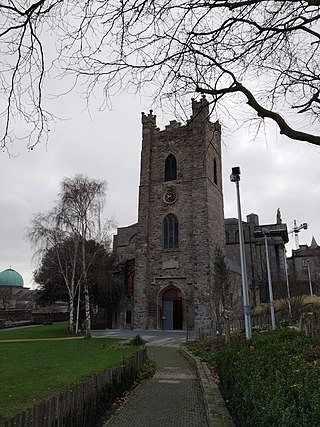Related Research Articles

Saint Patrick's Cathedral in Dublin, Ireland, founded in 1191 as a Roman Catholic cathedral, is currently the national cathedral of the Church of Ireland. Christ Church Cathedral, also a Church of Ireland cathedral in Dublin, is designated as the local cathedral of the Diocese of Dublin and Glendalough.

The Dean of St Patrick's Cathedral is the senior cleric of the Protestant St Patrick's Cathedral, Dublin, elected by the chapter of the cathedral. The office was created in 1219 or 1220, by one of several charters granted to the cathedral by Archbishop Henry de Loundres between 1218 and 1220.

The Dean of Christ Church Cathedral, Dublin is dean and head of the chapter of the Cathedral of the Holy Trinity, commonly called Christ Church Cathedral, which is the cathedral church of the United Diocese of Dublin and Glendalough in the Church of Ireland. The dean is appointed by the Church of Ireland Archbishop of Dublin. Aspects of the cathedral administration are overseen by the Cathedral Board, which the Dean chairs with both a regular and a casting vote.
William Moreton was an English prelate in the Church of Ireland who served as the Bishop of Meath from 1705-1716.
Samuel Pullen (1598–1667) was the Church of Ireland archbishop of Tuam in Ireland.

Benjamin Parry was Church of Ireland Bishop of Ossory from 27 January 1678 until his death later the same year.
Griffith Williams (c.1589–1672) was the Anglican bishop of Ossory. He was opposed to the Puritans.
John Parker was a Church of Ireland clergyman who came to prominence after the English Restoration, first as Bishop of Elphin, then as Archbishop of Tuam and finally as Archbishop of Dublin and Primate of Ireland.
Welbore Ellis (1651?–1734) was an English bishop of Kildare, bishop of Meath and Irish privy councillor.

Edward Parry was Church of Ireland Bishop of Killaloe, County Clare, Ireland from 28 March 1647 until his death 20 July 1650.
Edward Jones (1641–1703), was a Welsh Anglican bishop who served as Bishop of Cloyne and Bishop of St Asaph.
John Hartstonge or Hartstongue was an English-born prelate of the Church of Ireland who became Bishop of Ossory and then Bishop of Derry.
The Dean of Lismore is based at The Cathedral Church of St Carthage, Lismore in the united Diocese of Cashel and Ossory within the Church of Ireland.

The Dean of Cashel is the head of the Chapter of the Cathedral Church of St John the Baptist and St Patrick's Rock, Cashel, one of the Church of Ireland cathedrals of the united Diocese of Cashel, Ferns and Ossory.
The Dean of Kilkenny or Dean of Ossory is based at The Cathedral Church of St Canice, Kilkenny in the united Diocese of Cashel and Ossory within the Church of Ireland.
The Dean of Ossory or Dean of Kilkenny is based at The Cathedral Church of St Canice, Kilkenny in the united Diocese of Cashel and Ossory within the Church of Ireland.
Clonmethan is a townland and a civil parish in the ancient barony of Balrothery West, Fingal in Ireland. It is bordered by the parishes of Palmerstown to the west, Grallagh to the north, Hollywood to the northeast, Westpalstown to the east, Killossery to the southeast, Killsallaghan to the south, and Greenoge, County Meath to the southwest.

John Sterne (1660–1745) was an Irish Church of Ireland clergyman, bishop of Dromore from 1713 and then bishop of Clogher from 1717.

John Pooley (1645-1712) was a member of the Church of Ireland, who was Bishop of Cloyne from 1697 to 1702, then Bishop of Raphoe until his death in October 1712.
References
- ↑ Welch, H. T (2004). "Parry, John (d. 1677)". Oxford Dictionary of National Biography . Oxford University Press . Retrieved 19 November 2008.